Key takeaways:
- Software development sprints foster collaboration and accountability through regular check-ins and concise goal-setting.
- The iterative nature of sprints allows teams to adapt quickly to feedback, celebrate small victories, and maintain high motivation.
- Effective sprint planning includes defining goals, estimating effort, and solidifying team commitments.
- Utilizing the right tools, like project management and collaboration software, enhances productivity and communication during sprints.
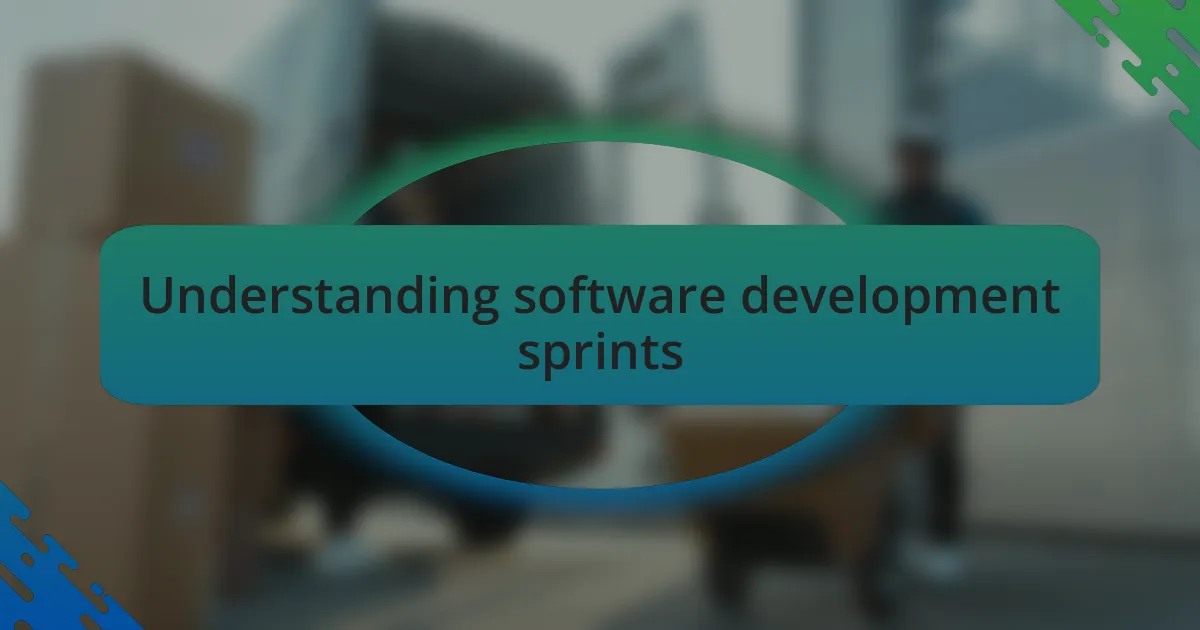
Understanding software development sprints
Software development sprints are short, time-boxed periods where a team works collaboratively to complete a defined set of tasks. I remember the first time I participated in a sprint; the energy was palpable. It felt like we were on a mission, and the focused time frame pushed us to think creatively and work efficiently. Have you ever felt that rush when deadlines are tight?
During a sprint, the team typically meets regularly, often through daily stand-ups, to discuss progress and roadblocks. This daily check-in was invaluable for me; it not only kept everyone aligned but also fostered a sense of accountability. It’s fascinating how, in just 15 minutes, we could turn frustration into solutions by sharing updates. What strategies do you find help the team stay motivated in such short intervals?
The key to a successful sprint lies in its goal-setting and prioritization. I’ve learned that clearly defined objectives lead to a more productive outcome. If the team is uncertain about what to prioritize, the sprint often ends up feeling chaotic. Have you experienced that before? Emphasizing clear goals helps transform chaos into a streamlined process, making every sprint feel like a step forward rather than just ticking boxes.
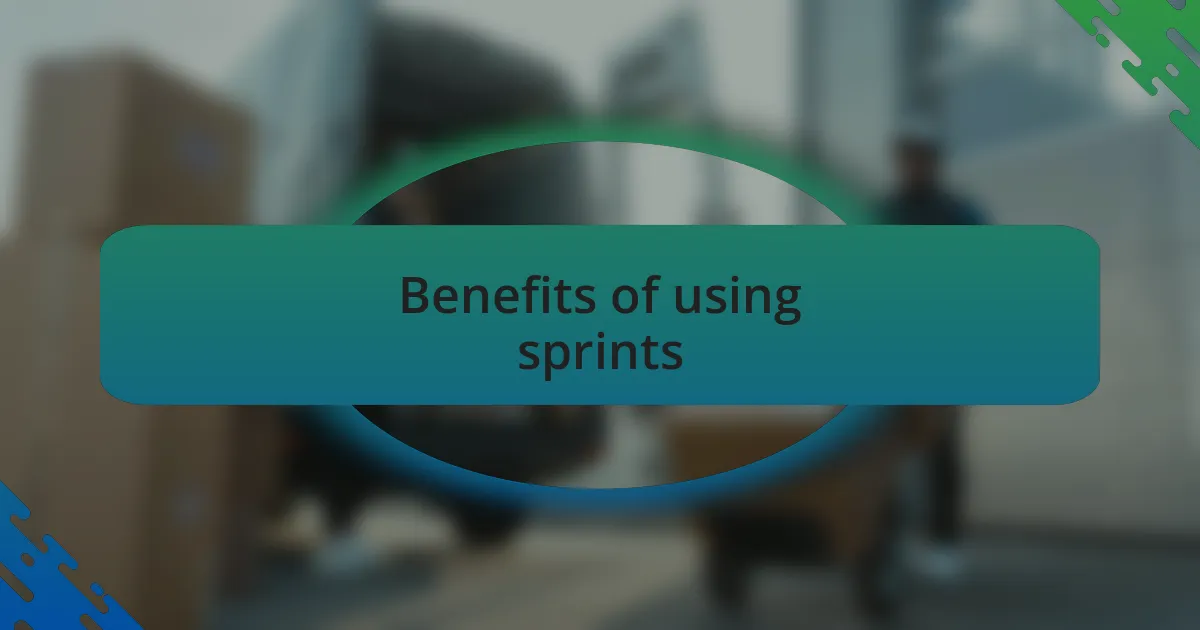
Benefits of using sprints
The benefits of using sprints in software development are numerous. For instance, I’ve noticed that working in short bursts allows my team to maintain high levels of focus and motivation. When there’s a clear target with a tight deadline, it feels like we’re racing toward a shared goal, creating a sense of camaraderie that fuels our creativity. Have you ever experienced that moment when you realize you’re not just getting things done, but thriving in the process?
One of the most rewarding aspects of sprints is the ability to adapt quickly. On several occasions, I found that feedback from team members during daily stand-ups led to immediate changes in our approach. This agility not only improves the project but also cultivates a culture of continuous learning within the team. Isn’t it empowering to know that we can pivot based on real-time insights rather than getting stuck in lengthy deliberations?
Moreover, the iterative nature of sprints allows us to celebrate small victories. I recall a project where we reached a milestone that, although minor, significantly boosted our morale and energy for the upcoming tasks. These moments of recognition encourage us to keep pushing, proving that incremental progress can be just as important as the final outcome. How do you celebrate successes within your team?
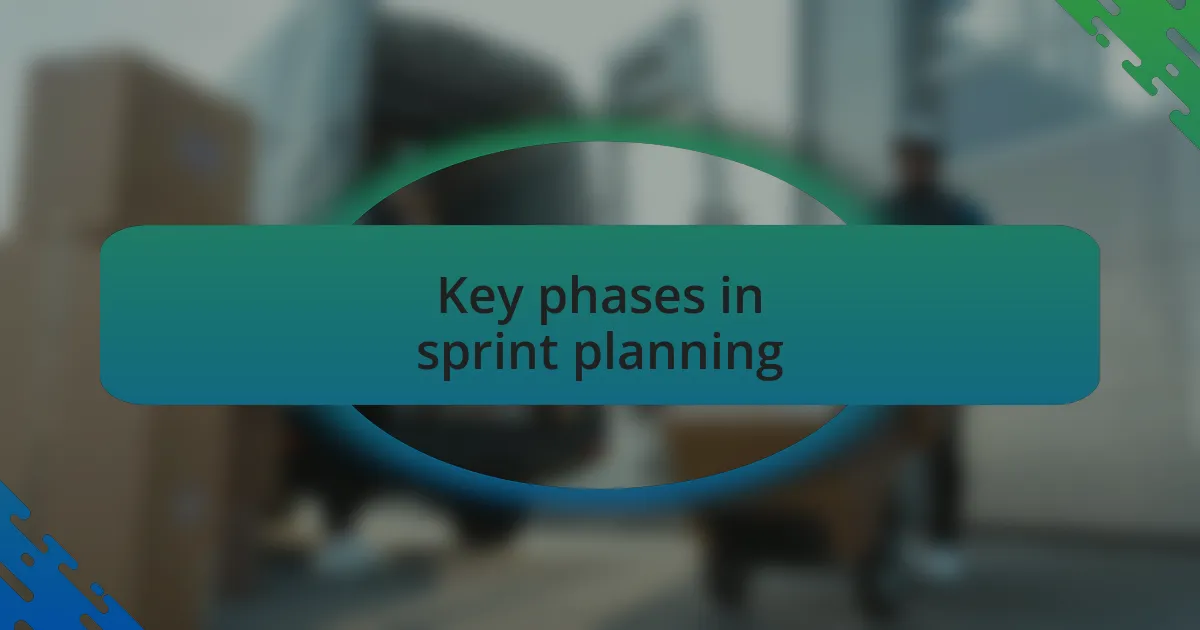
Key phases in sprint planning
When it comes to sprint planning, the initial phase is all about defining goals and scope. I often kick off this process by gathering the team to review our backlog and identify which items align best with our objectives. This aligns everyone’s focus and allows us to prioritize tasks based on value. Have you ever found that clarifying goals at the beginning makes all the difference in staying on track?
The next step involves estimating effort and assigning roles. I remember a time when we experimented with a new estimation technique called story points. This transformed our discussions, as it encouraged the team to share insights about the complexity of tasks rather than just the time it would take. It’s fascinating how a subtle shift in focus can lead to a more accurate understanding of project workload, don’t you think?
Finally, the commitment phase seals the deal. We make a collective agreement on what we can realistically achieve in the sprint. I’ve seen teams driven by a sense of accountability flourish during this phase—it’s exciting to see everyone energized and ready to dive in. This shared commitment not only strengthens our resolve but also fosters a supportive environment where each member feels empowered to contribute. How does your team solidify its sprint commitments?
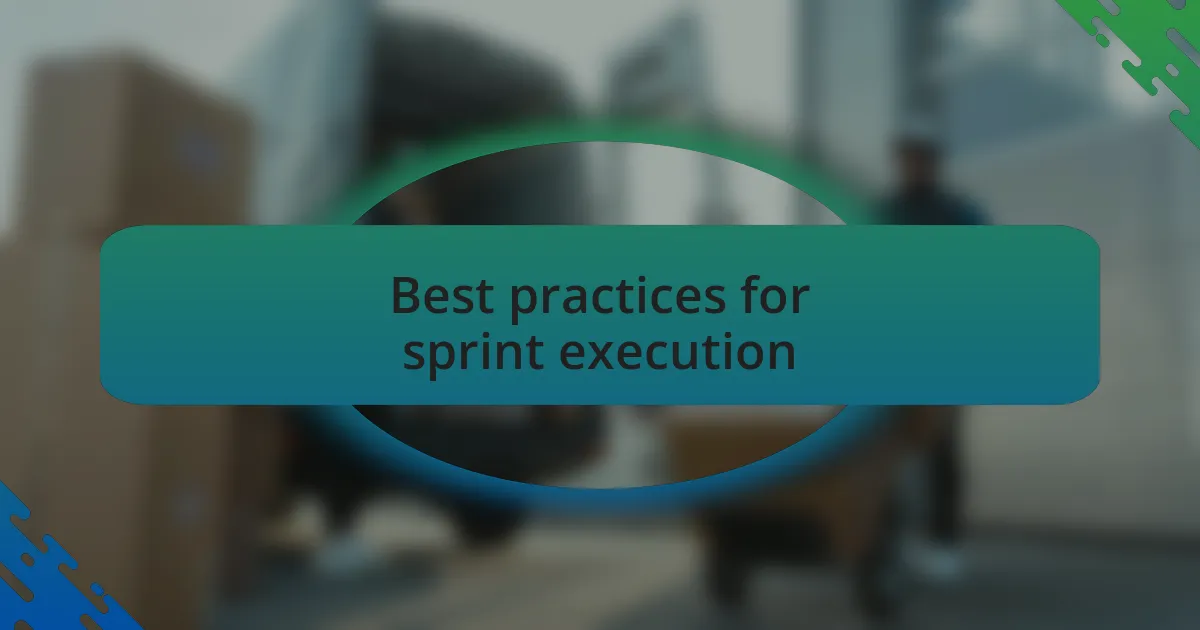
Best practices for sprint execution
I’ve discovered that clear communication is vital during sprint execution. Inviting team members to share daily updates opens up the floor for collaboration and problem-solving. I recall a challenging sprint where a simple check-in transformed our workflow. It allowed us to spot blockers early, ensuring we adapted quickly, rather than waiting until the end to face issues. Have you tried something similar in your team’s daily meetings?
Timeboxing is another practice that has served me well. For instance, I once led a sprint where we set strict time limits for discussions around specific tasks. This not only kept our focus sharp but also encouraged us to get to the heart of issues efficiently. It’s amazing how much can be accomplished when there’s a clear deadline in place!
Most importantly, I believe in celebrating small wins as we progress through the sprint. During one project, we made it a point to recognize completed tasks, no matter the size. This simple act created an uplifting atmosphere, reinforcing our motivation and team spirit. Do you think acknowledging progress could change the dynamics of your team’s mindset?
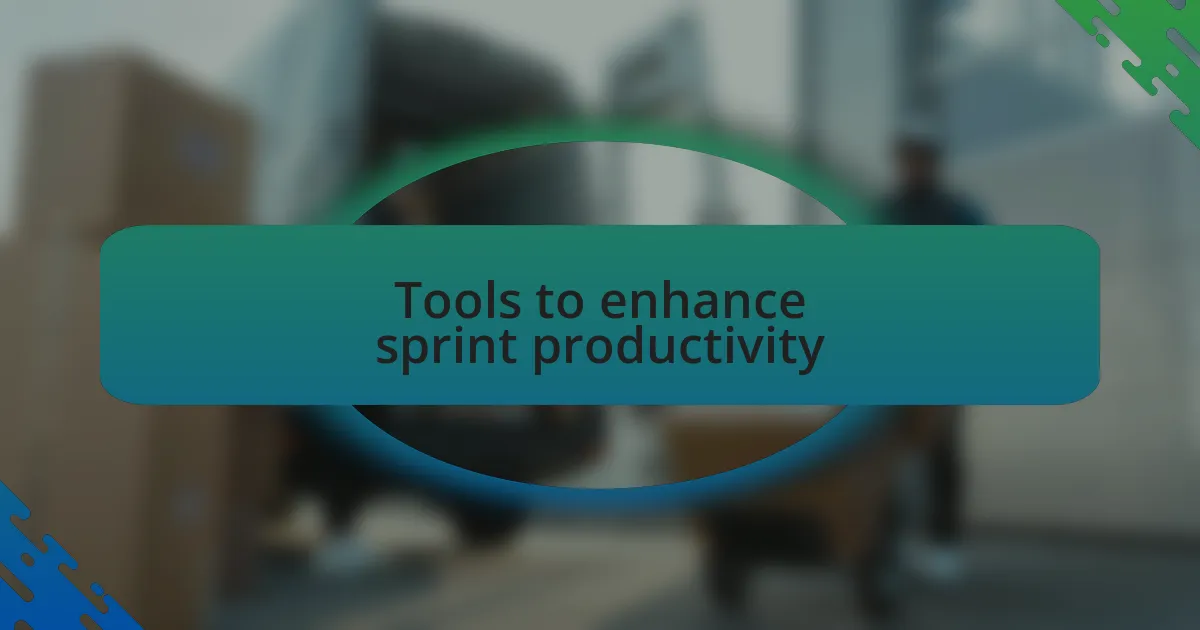
Tools to enhance sprint productivity
When it comes to enhancing sprint productivity, the right tools can make all the difference. I’ve found project management tools like Trello or Jira invaluable for tracking progress and assigning tasks. I remember a time when our team struggled with disorganization until we implemented a Kanban board. Suddenly, seeing tasks move from “To Do” to “Done” gave us a tangible sense of accomplishment that fueled our motivation. Have you experienced a similar shift in productivity with a specific tool?
Collaboration tools are also essential in maintaining momentum during sprints. I’ve relied heavily on Slack for seamless communication among team members. During one intense sprint, the instant messaging feature allowed us to address concerns on the fly rather than waiting for scheduled meetings. This quick back-and-forth proved crucial when we hit a technical snag; the faster our communication, the quicker we resolved issues. Don’t you think that having an open line can foster a more responsive team environment?
Equally important are tools for time management, like Pomodoro timers. I used a simple app that breaks work into intervals, which kept distractions at bay during a particularly tight sprint deadline. Each focused session felt like a race against the clock, pushing me to concentrate deeply. After a few cycles, I noticed my productivity soared, allowing us to deliver our project ahead of schedule. Isn’t it fascinating how something so simple can transform our ability to focus?
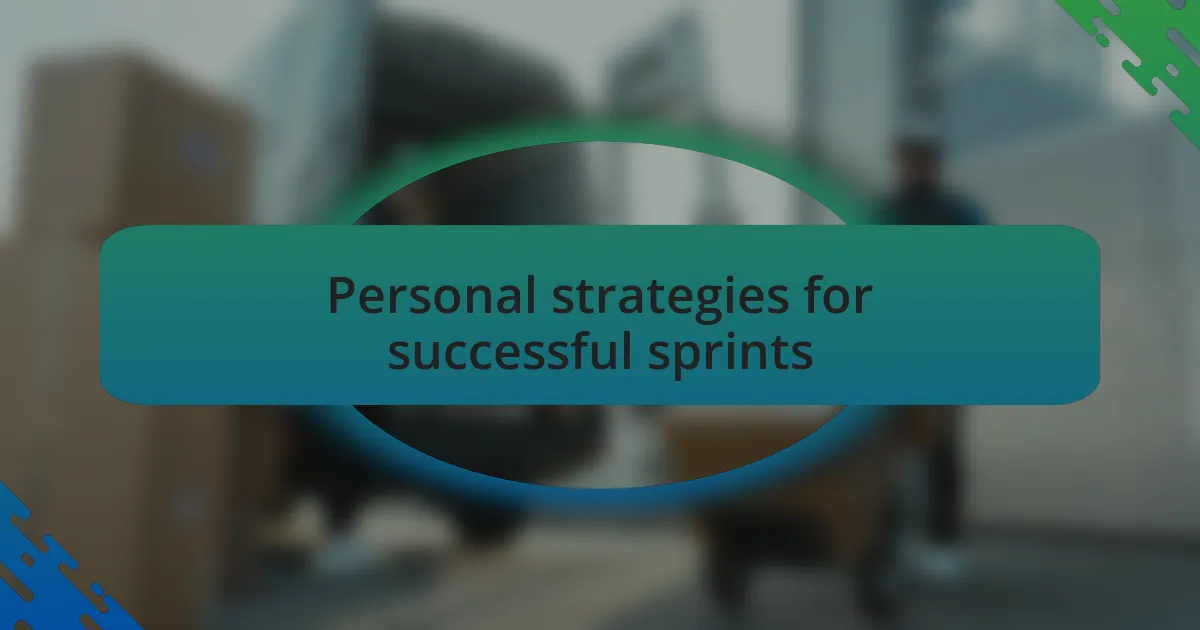
Personal strategies for successful sprints
One personal strategy I’ve found essential during sprints is setting clear, achievable goals at the start. I remember a sprint where we simply aimed to “get things done” without defined objectives. It led to confusion and frustration among team members. Now, I always break down tasks into smaller, specific goals. This clarity not only helps keep everyone aligned but also provides a sense of achievement as we check off completed items.
Timeboxing is another technique that significantly boosts my productivity. I usually allocate fixed time slots to specific tasks, which creates a sense of urgency. Just last week, I dedicated 30 minutes solely to debugging a stubborn error. At first, I felt overwhelmed, but as the timer ticked down, my focus sharpened. It was incredible to see how many solutions I could find in such a short time. Can you relate to that thrill of racing against the clock?
Additionally, I’ve learned the importance of regular check-ins with my team. Early in my career, I’d often wait until the end of a sprint to gather feedback. It often felt like opening a floodgate of issues. Now, I prefer holding brief daily stand-ups. Sharing what I accomplished the previous day and outlining my plans helps to keep everyone on the same page. Isn’t it refreshing to see how such simple exchanges can build stronger collaboration?